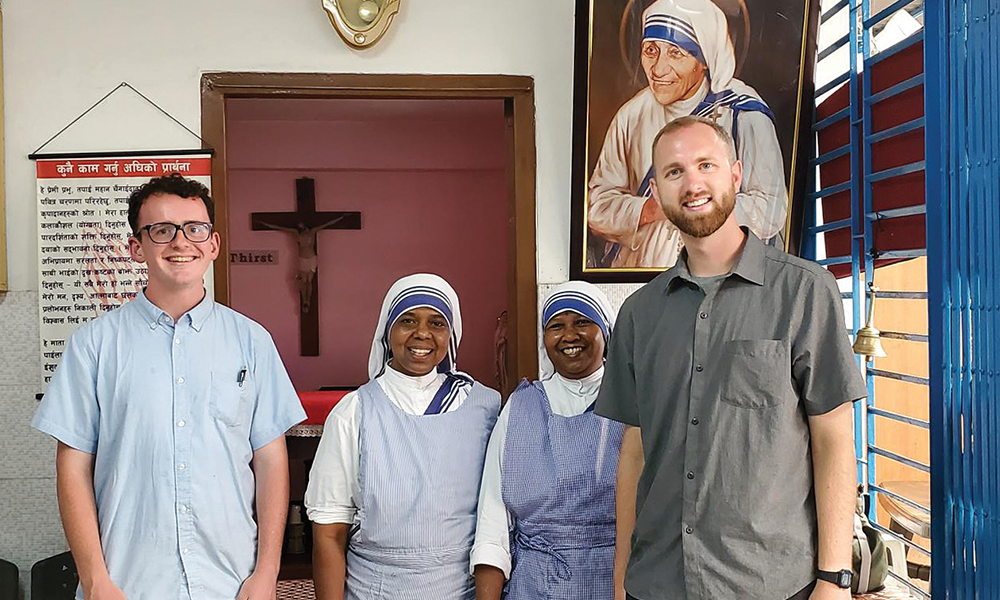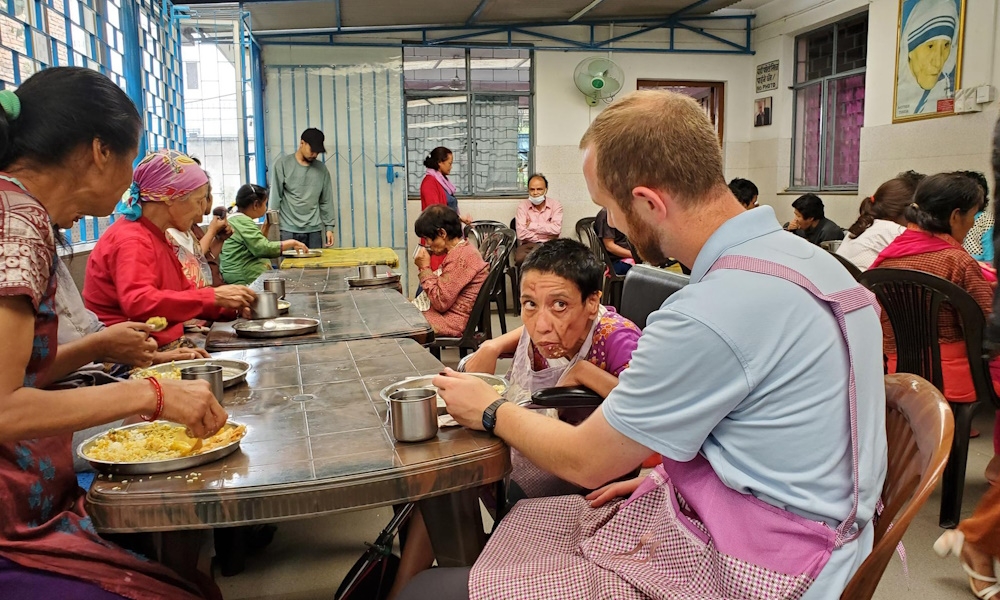
Growing in love halfway across the world
Seminarian reflects on summer missionary experience
Seminarian reflects on summer missionary experience
Editor’s note: Seminarian Charles Warner is a Year 2 theology student at the Pontifical North American College in Rome. His home parish is St. John Vianney in Saginaw. In July and August 2023, Charles served with the Missionaries of Charity in Nepal and India, as well as spent two weeks in a rural Nepalese parish. Edited by Danielle McGrew Tenbusch.
I learned about love in a nursing home half a world away.
I was staying at a Jesuit community house in Kathmandu, Nepal, during my summer break from seminary. Each day, I bicycled through the city streets and alleyways to volunteer at Shanti Bhawan, a home run by the Missionaries of Charity sisters for elderly women who were previously homeless, abandoned or neglected. Most of the women were developmentally or physically disabled. None spoke English, and I spoke only three words of Nepalese.
It was here where God was calling me to love in a new and profound way.
Encounters, not tasks
Before leaving for Rome to continue my seminarian formation, Bishop Robert Gruss encouraged me to get to know the universal Church. The universal Church can be understood by its primacy and unity in Rome, with the Pope and the Vatican, along with the presence of the Church throughout the whole world in a variety of cultures.
As I was deciding what to do for the summer, I heard Jesus speaking to me to leave the comforts of the Western world and go experience life in a developing country. I mentioned this to my dad, Deacon Rick Warner (Nativity of the Lord Parish, Alma), and through a series of connections, I was welcomed to Nepal by Jesuits ministering there.
In Kathmandu, I stayed in a Jesuit community house and served at Shanti Bhawan with the Missionaries of Charity. Each day, an elderly woman named Sopana needed help eating her lunch, as her hands and arms were significantly limited in motion and her fingers were very stiff. I mixed dal with rice and vegetable curry, then fed her with a spoon. I patiently waited after each bite, ensuring she was swallowing her food and ready for the next spoonful. Sometimes, she would point or nod that she was ready if I was a bit too patient.
Love is a choice. By choosing love in each human interaction, we are images of God’s own love for that person: we express our care and recognize their goodness. If we don’t choose love, we may treat the encounter as a task to be accomplished and diminish our view of that person’s humanity.
After she finished eating, I remained with her rather than moving on to the next task. Sopana then clutched my hands and brought them to her forehead and then to her mouth to kiss them. This was her way of saying, “thank you for allowing your hands to be my hands.”
Her gesture was so gentle, loving and innocent. Afterwards, Sopana had a beaming smile on her face. By choosing love, I was able to receive her love in return.
After this experience, I wanted to feed her again the following days because of the tender appreciation and love she showed me. I had a desire to love her more in return and see more and more of her strengths, weaknesses, joys and sorrows— even though there was no spoken communication between us.
She opened my heart to know her in her totality, not just by her suffering and limitations. My heart was truly moved to love her and not just have compassion for her.
Simple joys
My next stop was Maheshpur (Bhadrapur) in rural southeast Nepal. I stayed at a Jesuit-run parish, St. Xavier’s Catholic Church, which also had a pre-K through 10th grade school named Moran Memorial School. Both were located in a tea garden and offered education and worship to the families who lived and worked there.
While there, I learned a great deal about the Nepalese culture and the lives of the people. I greeted the children before and after school and occasionally served as a substitute teacher, since Moran Memorial School taught in English. Some evenings, I visited nearby Catholic villages with the pastor.
These five villages were about the size of a football field with 20 to 50 interconnected homes built of bamboo sticks and stucco or cement. During these visits, all of the children gathered together along with some of the adults and elders. Everyone was excited for the visit, and the kids were always intrigued about me. I was happy to answer any questions they had about me and to learn from them when they wanted to share.
I also brought along more than 200 rosaries to hand out. The excitement and reverence of the kids to receive a rosary was like a toddler getting ready to hold their newborn brother or sister.
Christianity makes up less than 5 percent of the Nepal’s population, and yet they were not shy or embarrassed to display their faith by wearing rosaries around their neck or by the greeting “jai Yeshu” (praise Jesus).
My time there very much attuned me to the joy and love they shared with each other and for God amidst the simplicity of life.
Patience and presence
My last stop was Kolkata (Calcutta), India, where I volunteered again with the Missionaries of Charity. I have always been drawn to Mother Teresa’s witness of Christ in her joyful service and prayer. Knowing that I would be in Nepal and so close to Kolkata, I had to visit and volunteer through the Motherhouse of the Missionaries of Charity Sisters, where the order began, and venerate the relics of St. Mother Teresa at her tomb.
My time in Kolkata really challenged me. The daily schedule, the commute across the city, the surprising situations and the health conditions of the people all weighed on me. Yet my day was always centered on prayer starting with Mass and then private prayer in the morning, midday and evening. Keeping God at the center helped strengthen me despite the surprises and challenges that attacked my weaknesses.
In the morning, I was assigned to Daya Dan, a home for disabled children. There, I helped feed teenagers with Down syndrome who had a difficult time with motor skills and swallowing. It would seem as if every spoonful of pureed/blended food that I would put in the child’s mouth would drool back out. I would be feeding one child for 45 minutes and the amount of puree in the bowl did not seem to be any less. I had to guard the bowl of food to prevent the child from knocking it over, while at the same time spoon-feeding him and trying to help the child to swallow by keeping his head upright and not bowed down.
I felt helpless. I failed in all my own measurements. I had no idea how to best feed the child and the meal took so long that it felt like by the end, it was time for the next meal. I had to let go of control, expectations and frustrations in order to be present in the moment, as I knew God was calling me to be, and simply do the best I could.
Then, in the afternoon, I went to Nirmal Hriday, a home for the sick and dying located next to the significant Hindu Kalighat Kali Temple. There, elderly men and women stayed in anticipation of death. Seeing how the residents their continued to help and care for each other is what impacted me the most. These were people coming to the end of their own lives, and yet they continued in their good works by being charitable to their neighbors. Love doesn’t stop, no matter the age or circumstances.
I reflected on how just as I maintained my presence to the residents, God maintains his presence to me— and to you. God is always with us. Placing God at the center of my life, as the source of all that I am and do, facilitated me to better love myself, God and neighbor in complete peace and joy.
Love is found in the present moment
These mission experiences of the universal Church in the Indian subcontinent, so different from my home and yet filled with the same children of God, helped me to have a deeper understanding of love and have moved me to really express love more to others. Not only in how I love, but how I give and receive love. Not only in the love of others, but in the love of God. The love of God is always present to us.
To love is to truly care for another as a person, to see the beauty of Christ in them. Love can be expressed by smiling, by enthusiasm, or simply by being present.
Perhaps love is what I discovered most during my time in Nepal and India. Love is found in the present moment, in the person or people encountered as they are— not who they were or might be in the future. To love is to love the person as they are present before you. We love Jesus both as he was bloodily present on the Cross and as he was gloriously present in his transfiguration. We love all those in need, whose language we cannot understand, just as we love our own families.
While last summer was an opportunity to encounter Christ across the world, I look forward to returning to the Diocese of Saginaw this upcoming summer and seeing Christ in the Diocese I call home. Wherever I am called to serve, my prayer is that I will continue to be present and to love.
IS GOD CALLING YOU OR SOMEONE YOU KNOW TO THE PRIESTHOOD? LEARN MORE HERE

